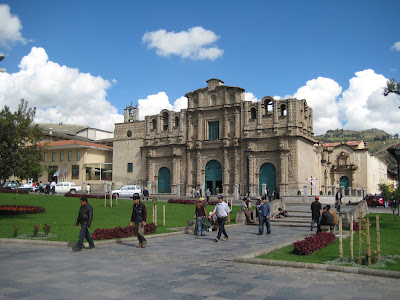After our one full day in Chiclayo and Lambeyeque, we headed to Chepen (the aforementioned “ancestral” homeland of Cesar’s clan). We had a lovely visit in that city with distant relatives who demonstrated graceful hospitality even though our visit was a complete surprise. At 11pm we boarded a bus for the five hour trip to the city of Cajamarca in the Northern highlands (2800 meters a.s.l.), where the last Inca leader, Atahualpa, was captured by Francisco Pizzaro in 1532.




Hotel options are slim when one arrives in a town at 4am, but someone did respond to our banging on a door in the town square and we all flopped down for a rest in a hotel low in amenities but high in character. With rumbling stomachs we headed out for breakfast around 8am and managed to find some turkey sandwiches (turkey sandwiches are a typical breakfast in most of Peru, accompanied by fresh fruit juice or god-awful instant coffee). After admiring the graceful colonial Plaza de Armas with its intricate antique wooden balconies, 350 year old fountain and fantastically ornate baroque cathedral, we visited the infamous chamber where Atahualpa was kept after his capture. A red line on the wall memorializes where he reached up and indicated how high his subjects would fill the large room with gold and silver to secure his release. He was clearly a tall man. Sadly, despite the ransom treasure, Pizarro drew up charges against Atahualpa and had him executed anyway. The Inca Empire quickly toppled under cruel European domination.

From one empire to another: our next stop was a mind boggling example of the excess adornments of the Catholic Church. This particular church however is a museum now and not a working church controlled by the Vatican. Our guide also gave us a very educational tour of the church’s hospital, also restored, and a museum of the local Cajamarquina culture. Interestingly, after the municipality’s complicated and expensive renovation of this once neglected and ruined space, now extraordinary and well maintained, (the church courtyard was used as a garbage dump before the renovation), the Catholic Church wants it back.

After hearing of that dirty business with the Church, we needed a bath. A 15 minute taxi ride took us to Los Baños del Inca – sulphurous thermal springs where Atahaulpa himself took the healing waters. The water’s natural temperature is 78 degrees Celsius. To make the water bearable, some is cooled and then mixed in with the hot. We enjoyed a leisurely soak in our individual private baths and then went in search of typical Norteño cuisine. Peruvian cuisine is varied, interesting and always delicious. More on this subject later.




